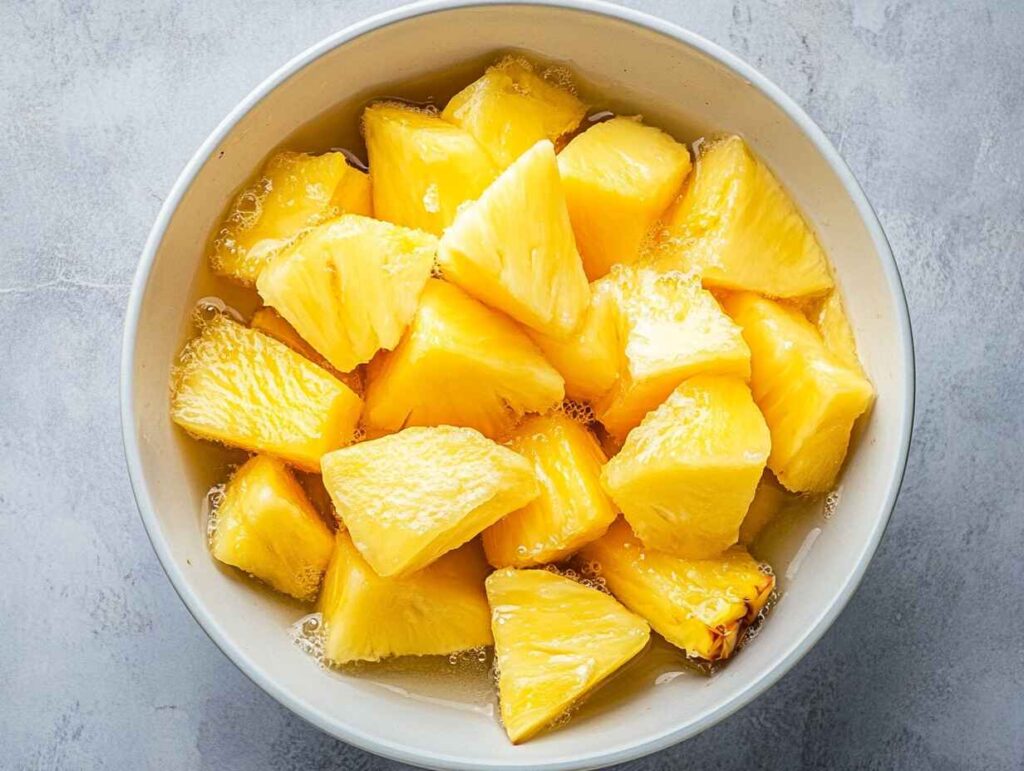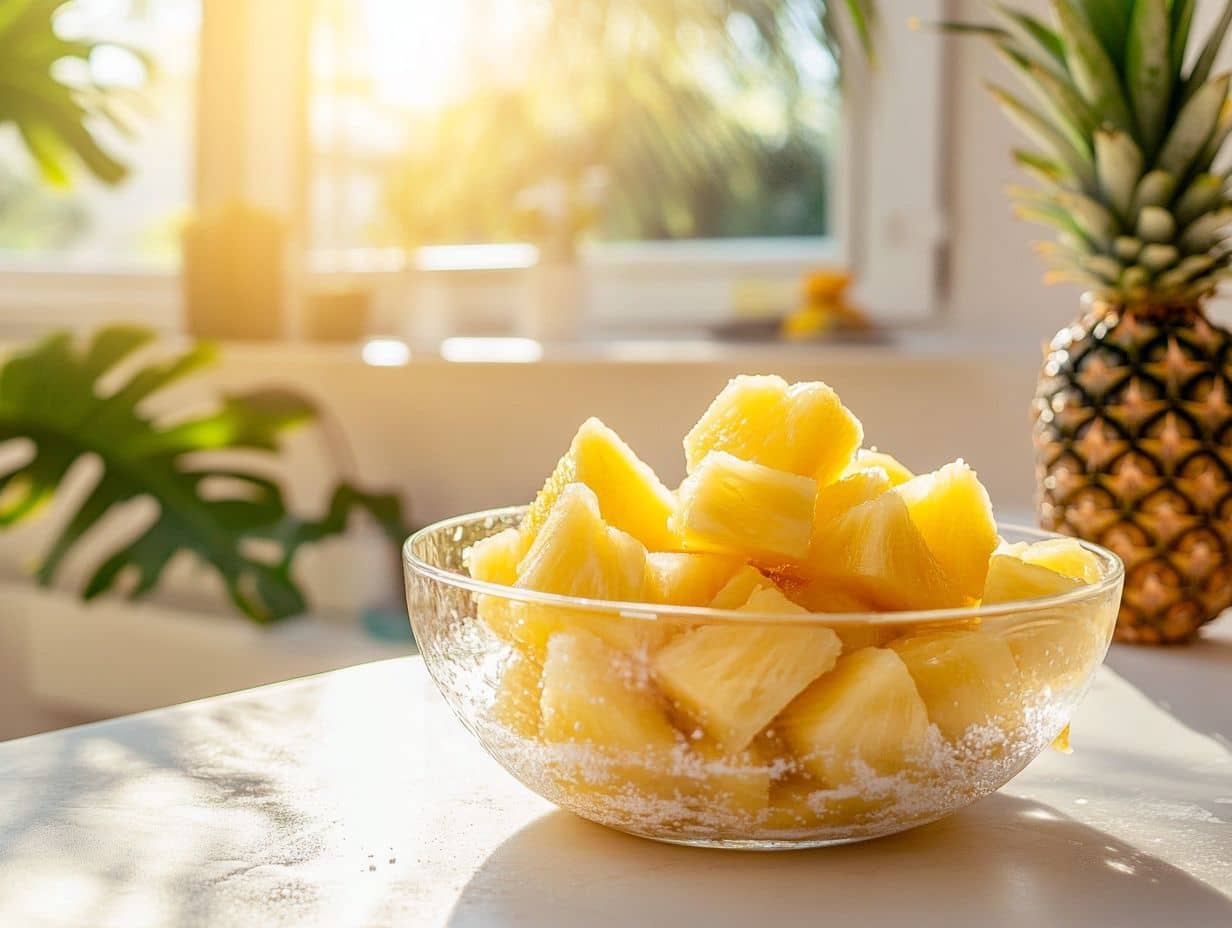why you should soak pineapple in salt water? Pineapple, with its sweet and tangy flavors, is a tropical delight enjoyed worldwide. However, that tingling or slight burning sensation you experience after eating fresh pineapple can be unpleasant. This is where soaking pineapple in salt water makes a difference. Backed by science, tradition, and practicality, soaking pineapple in salt water enhances its flavor, reduces irritation, and makes it even more enjoyable. It’s a simple yet effective hack every pineapple lover should try.
Table of Contents
The Science Behind Soaking Pineapple in Salt Water
Understanding the Nutritional Profile of Pineapple
Pineapple isn’t just a tasty treat it’s loaded with important nutrients. It’s rich in vitamins like C and B6 and minerals like manganese, which help boost your immune system and keep you healthy. Pineapple also contains bromelain, a special enzyme that supports digestion and helps reduce inflammation.
Here’s a quick look at the nutritional content of pineapple (per 100g):
| Nutrient | Amount |
|---|---|
| Calories | 50 kcal |
| Vitamin C | 79% DV |
| Carbohydrates | 13g |
| Fiber | 1.4g |
| Sugar | 9.85g |
| Bromelain Enzyme | Present |
The Role of Bromelain in Pineapple’s Effects
Bromelain, a natural enzyme in pineapples, is both interesting and a bit tricky. On one side, it breaks down proteins, which is why it’s great for meat marinades. On the other, it’s the reason for that tingling or mild irritation you might feel when eating fresh pineapple. In particular, bromelain can bother sensitive areas like your tongue and the roof of your mouth. Thankfully, soaking pineapple in salt water helps ease this effect, making it much more pleasant to enjoy.
Common Issues with Eating Fresh Pineapple
Tingling and Irritation: Why It Happens
Ever wonder why your tongue feels funny after biting into pineapple? Well, here’s why: the enzyme bromelain is quite the busybody. Specifically, it breaks down proteins in your saliva and tissues, causing that signature tingle or mild discomfort. As a result, in some cases, this can even lead to a sore mouth after consuming too much fresh pineapple.
“Eating pineapple is like a mini science experiment on your tongue bromelain is literally trying to ‘digest’ you!”
If this sounds familiar, you’ve already got one great reason why you should soak pineapple in salt water. It’s a simple way to reduce irritation and enjoy your fruit without discomfort.
Allergic Reactions and Sensitivities
While rare, some people experience allergic reactions to pineapple, ranging from mild itching to severe swelling. If this happens to you, it’s another reason why you should soak pineapple in salt water. By soaking the fruit, you neutralize bromelain’s potency, making it gentler on your system and safer to enjoy.
Benefits of Soaking Pineapple in Salt Water

Neutralizing Acidity and Reducing Irritation
Why you should soak pineapple in salt water becomes clear when you think about its acidic nature. Salt water works like a magical neutralizer. Bromelain’s activity is toned down significantly by the ions in salt, helping to curb its intense effects on your mouth. This means no more unpleasant tingling or burning after enjoying your favorite tropical treat.
Enhancing Flavor for a Better Taste
Salt is a natural flavor enhancer, another key reason why you should soak pineapple in salt water. When soaked, the salt not only reduces irritation but also amplifies the fruit’s natural sweetness, creating a perfectly balanced taste. Think of it as the secret seasoning that takes pineapple to the next level.
“It’s like adding a pinch of salt to caramel you wouldn’t expect it to work, but it’s magical!”
Removing Residual Dirt and Impurities
Pineapples grow close to the ground and often carry residues of soil, pesticides, or bacteria. This is yet another practical reason why you should soak pineapple in salt water. A quick soak ensures these impurities are washed away, leaving you with clean, fresh, and safe fruit to enjoy.
How to Properly Soak Pineapple in Salt Water
Step-by-Step Guide to Soaking Pineapple
Soaking pineapple isn’t complicated; it’s as easy as making lemonade. Follow these steps:
- Prepare Your Ingredients:
- 1 medium-sized ripe pineapple
- 1 teaspoon of salt
- 2-3 cups of clean water
- Slice the Pineapple: Peel, core, and cut the fruit into bite-sized pieces.
- Create the Salt Solution: Dissolve salt in water in a large bowl. Ensure the salt is evenly distributed.
- Soak the Pineapple: Place the pieces into the bowl and let them sit for 10-15 minutes.
- Rinse and Serve: After soaking, rinse the pineapple pieces under clean water to remove excess salt. Enjoy!
Discover more about the science of soaking fruits in this in-depth explanation.
Choosing the Right Type of Salt for Maximum Benefits
Not all salts are created equal. While table salt works fine, using sea salt or Himalayan pink salt adds a mineral boost to your soaking solution. These salts contain trace elements like magnesium and potassium that enhance the nutritional value of your pineapple.
Myths and Misconceptions About Soaking Pineapple in Salt Water
Does Soaking Remove Nutrients?
Contrary to popular belief, soaking pineapple in salt water doesn’t significantly diminish its nutritional value. The process mainly targets bromelain and acidity, leaving the vitamins and minerals intact.
Is Salt Water Harmful for Consumption?
Some worry that residual salt might make the pineapple unhealthy. However, a quick rinse after soaking ensures that only the benefits remain, without turning your pineapple into a salty snack.
Comparing Pineapple Soaking Practices Across Cultures
Traditional Uses in Tropical Regions
In tropical regions like the Philippines, Thailand, and parts of South America, soaking pineapple in salt water is a long-standing tradition. Not only do locals believe this practice enhances the fruit’s natural sweetness, but it also makes it easier to digest. In these areas, fruits are often enjoyed fresh, and adding salt water to the process is considered both a culinary and hygienic step.
Furthermore, in some cultures, a sprinkle of salt isn’t just for soaking it’s part of serving! People dip pineapple slices in a mix of salt and chili powder, creating a tangy-sweet-spicy experience that’s as delightful as it is unique. For additional cultural insights, explore how pineapple is paired with vegetables in global cuisine.
“For many, soaking pineapple is more than a kitchen hack it’s a ritual steeped in tradition and taste.”
Modern Health Trends and Adaptations
With the rise of health-conscious eating, the salt-water-soaked pineapple trend has seen a revival. Food enthusiasts and wellness advocates share their own spin on the process, recommending everything from mineral-rich salts to infused waters with mint or lemon. These adaptations make soaking pineapple not just practical but also gourmet.
The Chemistry of Pineapple and Salt Water Interaction
What Happens at the Molecular Level
The interaction between pineapple and salt water is truly fascinating. Essentially, the salt ions disrupt the bromelain enzyme’s ability to act aggressively on proteins. This process “calms” the enzyme, reducing its potential to irritate the sensitive tissues in your mouth.
Meanwhile, the osmosis process draws out excess acids from the pineapple’s cells into the salt water, further mellowing the fruit’s sharpness and enhancing its overall taste.
The Role of Osmosis in the Process
Osmosis the movement of water and dissolved substances across a semi-permeable membrane is key here. When pineapple is soaked, salt water pulls impurities and excessive acidity out of the fruit. The result? A fruit that’s not only easier on your taste buds but also cleaner and more refreshing.
“Think of osmosis as a spa day for your pineapple soothing, cleansing, and enhancing its natural beauty!”
Frequently Asked Questions About Soaking Pineapple in Salt Water
Can soaking prevent allergic reactions?
While soaking pineapple in salt water doesn’t completely eliminate allergens, it reduces bromelain’s activity, which might help mitigate minor sensitivities. If you’re prone to allergic reactions, soaking is a simple precaution worth taking.
How long should you soak pineapple?
The ideal soaking time is 10-15 minutes. This window is long enough to reduce bromelain’s effects and balance the fruit’s flavors without compromising its texture or nutrients.
Can you soak pineapple overnight?
It’s not recommended. Soaking for too long can waterlog the fruit, diluting its natural sweetness and altering its texture. If you must prep ahead, keep the soaking time short and store the fruit in an airtight container afterward.
Is it safe to use iodized salt for soaking?
Yes, iodized salt is perfectly safe. However, for added flavor and potential health benefits, opt for natural salts like sea salt or Himalayan pink salt.
Can you reuse the salt water for other fruits?
It’s better not to. Once the salt water has been used for pineapple, it contains impurities and acidity drawn from the fruit. Always prepare a fresh solution for other fruits.
Does soaking affect the pineapple’s shelf life?
Yes, but positively! Soaking cleans the fruit, removing impurities that could cause spoilage. However, always store soaked pineapple in an airtight container in the refrigerator for maximum freshness.
Tips for Selecting the Perfect Pineapple for Soaking
Identifying Ripe and Fresh Pineapples
Choosing the right pineapple is the first step toward an amazing experience. Look for these signs:
- Color: A ripe pineapple has a vibrant golden-yellow hue at its base.
- Smell: It should have a sweet, fragrant aroma. Avoid any pineapple with a sour or fermented scent.
- Texture: Gently press the skin it should yield slightly but not feel mushy.
| Checklist for Ripe Pineapple | What to Look For |
|---|---|
| Skin Color | Golden yellow |
| Aroma | Sweet and fragrant |
| Texture | Slightly firm |
| Leaves | Green and fresh |
Read more about how to make pineapple casseroles for the holidays for unique culinary applications.
Storing Pineapple After Soaking
After soaking, make sure to pat the pineapple pieces dry with a clean kitchen towel. Store them in an airtight container and refrigerate. Properly stored, soaked pineapple can last for up to three days while retaining its flavor and texture.
Exploring Alternatives to Salt Water for Pineapple Preparation
Using Sugar Water for a Sweeter Touch
If you’re not a fan of salt, don’t worry sugar water is a great alternative. Simply dissolve a teaspoon of sugar in a bowl of water and soak the pineapple for 10 minutes. This way, the method enhances sweetness without affecting the natural taste of the fruit.
Natural Flavor Enhancers for Pineapple
For a creative twist, try soaking pineapple in flavored water. Add herbs like mint or spices like cinnamon to your soaking solution for a unique flavor profile. This method not only reduces acidity but also infuses the fruit with aromatic notes.
“Experiment with flavors it’s like turning your kitchen into a mini food lab!”
Conclusion: Enjoying Pineapple Safely and Deliciously
Soaking pineapple in salt water might seem like an extra step, but it’s one that’s well worth it. Not only does it enhance flavor and reduce irritation, but it also ensures the fruit is clean and safe to eat. In fact, this simple practice can completely transform how you enjoy this tropical treasure. So, the next time you slice into a juicy pineapple, give it a quick salt-water soak it’s the small details that truly make the biggest difference.
Exploring More Alternatives to Salt Water for Pineapple Preparation
Lime Juice for a Tangy Twist
Lime juice offers a delightful alternative to salt water, providing a tangy boost that complements pineapple’s natural sweetness. Simply squeeze the juice of one lime into a bowl of water and soak the pineapple pieces for about 10 minutes. This method also adds a dose of Vitamin C and gives the fruit a refreshing zest.
Coconut Water for Tropical Fusion
Why not take the tropical vibe up a notch? Soaking pineapple in coconut water not only helps neutralize acidity, but it also infuses the fruit with a subtle, nutty sweetness. Additionally, this method is especially popular in island cultures, where both ingredients are fresh and abundant. For an exotic treat, serve this combo as a chilled snack that’s perfect for sunny days!
“Pairing pineapple with coconut water is like giving your taste buds a vacation to the tropics!”
Herbal Infusions for a Gourmet Experience
Herbs like rosemary, mint, or basil can be steeped in warm water and then cooled before soaking pineapple. These natural infusions add an elegant touch to the fruit, making it perfect for sophisticated dishes or refreshing salads.
The Broader Health Benefits of Prepping Pineapple
Better Digestive Health
Soaking pineapple, no matter how you do it, can make it gentler on your digestive system. In particular, it tones down the bromelain, which might bother sensitive stomachs. As a result, this simple step turns pineapple into a safe and enjoyable snack for anyone with mild digestion issues. Moreover, it ensures that even those with sensitive stomachs can enjoy its tropical goodness.
Boosting Hydration and Electrolytes
Using alternatives like coconut water or herbal solutions for soaking can add nutrients and electrolytes to the fruit. These added benefits make the pineapple more hydrating and energizing, especially after a workout or on a hot day.
Elevating Culinary Creativity
Pre-soaked pineapple becomes a versatile ingredient, effortlessly blending into recipes ranging from desserts to savory dishes. Moreover, by experimenting with different soaking methods, you unlock a whole new world of flavors and possibilities.
Final Thoughts on Soaking Pineapple
Soaking pineapple in salt water or other simple solutions isn’t just a healthy choice it’s a way to bring out the best in the fruit’s natural taste. Whether you enjoy the salty touch of salt water, the bright tang of lime, or the gentle sweetness of coconut water, soaking pineapple in salt water is a foolproof way to enhance flavor and reduce irritation.
The next time you enjoy pineapple, take a little extra time to prepare it by soaking pineapple in salt water. This small step will not only make it taste better but also help prevent irritation. After all, soaking pineapple in salt water is about more than just preparation it’s about enjoying the experience, keeping traditions alive, and getting creative. 🌴🍍

